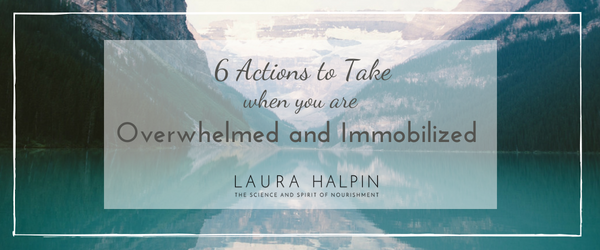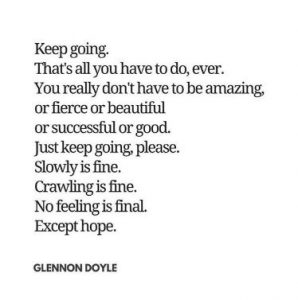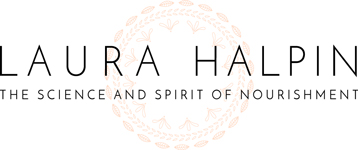
What you can do when you are feeling overwhelmed and immobilized.
If you're feeling overwhelmed by the events in our country or by your own life's circumstances, you are not alone.
In times of great tumult, we must cultivate a sense of steadiness within ourselves. This can really only happen if we develop practices that help us stay sane and grounded.
When we are overwhelmed and immobilized, the body cannot shift itself into a place of clarity and calm.
I humbly submit a variety of things you can do when defeat hits and you're not sure how to find your footing.
Try one or two that resonate. And then practice, because so often the body doesn't immediately respond to your kindness when in a state of panic or depression. You want to build some trust by taking small actions repeatedly over time.
Count of Four Breathing
Of all the things I teach my clients, this is one of the most powerful and effective practices. Super accessible. This is how you do it:
- Breathe in to the count of four (1...2...3...4...)
- Hold your lungs full of oxygen to the count of four (1...2...3...4...)
- Exhale to the count of four (1...2...3...4...)
- Leave your lungs empty to the count of four (1...2...3...4...)
- Repeat this cycle four times
- Repeat the entire thing four times during the day
The science: according to Kelly McGonigal, PhD, author of Neuroscience of Change and Willpower, lengthening the breath to four to six cycles per minute strengthens the pre-frontal cortex. The increased activity of the pre-frontal cortex is associated with increase happiness and decreased depression and anxiety. Deep breathing fires the pre-frontal cortex. The amygdala, that fear-mongering touchy fight-or-flight part of the brain, cannot fire at the same time the prefrontal cortex is. The action of the pre-frontal cortex inhibits amygdala activity.
Thanks to neuroplasticity, practicing count of four breathing over time can make it easier to stay out of fight or flight (or get yourself out of it more quickly).
I recommend that you practice this exercise before your feet hit the ground in the morning, when you close your eyes at night, and two other times during the course of the day, preferably when you are triggered, angry, overwhelmed, lonely.
Ground
Anyone who has ever stood in a forest, hugged a big tree or sat at the ocean knows that there is an energetic benefit to being in contact with nature.
"Grounding" or "earthing" refers to direct skin contact with the surface of the earth.
According to the conclusion of this study published in The Journal of Public Health, "Emerging evidence shows that contact with the Earth—whether being outside barefoot ...may be a simple, natural, and yet profoundly effective ... strategy against chronic stress, ANS dysfunction, inflammation, pain, poor sleep... and many common health disorders, including cardiovascular disease."
How does one ground? Get outside and walk barefoot, dig in the garden, pull weeds...anything to get one's body in direct contact with the earth.
One way that I add to the power of grounding is to imagine that I'm sending down roots from my own body down to the center of the earth. As I breathe, I draw up the earth's energy up those roots and into my body. To me, earth energy is grounding, empowering, magnetic, stabilizing and nourishing. What does it feel like to you?
You can also imagine that your anxious feelings are being absorbed by the earth and dissipating from your body.
The earth's energy is available to us every day. Draw on it.
Explore One of Your Senses
Our five bodily senses are touch, sight, hearing, taste and smell. By choosing one of these senses to explore in any given moment, we take ourselves out of our heads (where it can be scary and dangerous) and into our bodies.
What does it mean to "explore one of your senses"?
Well, in this moment, I can stop what I'm doing and explore my sense of hearing. If I am quiet and "lean into" the sounds around me, I can hear many layers of sound: a water fountain in my yard, the buzz of a lawn mower, the sound of a car driving by, my dog quietly snoring at my feet and two different birds chirping.
Had I not taken this moment, I would have missed it all.
Or I can explore the sense of touch: In this moment, I can feel where my right foot comes in contact with the floor, I can feel my left foot where it crosses over my right. I can feel my clothes where they are coming into contact on my legs, chest, shoulders and arms. I can feel my hair touching my neck and forehead. I can even feel my scalp and the air that is coming in contact with my bare cheeks.
Lingering in any one of your senses brings you into the present moment, and out of the past or future where anxiety and overwhelm sap your joy and hope.
Shit River
This is a metaphor that I've been using for years and every single time I do this meditation, I experience a significant shift.
For those of us who have a propensity for anxiety/negative/obsessive thinking, no matter what the origin or severity, it’s paramount to learn how to manage our thought lives.
And yet, trying to stop negative thinking, or “not feel” our anxiety can create a resistance that actually exacerbates the misery. What we resist persists, right?
When I am experiencing anxiety, I remind myself of “Shit River,” a metaphor that came to me that has made a huge difference in the way I experience and “deal with” anxiety and negative emotions in general.
Try this:
Imagine that there is a polluted, noxious river of thoughts that flows through your mind. I call it Shit River, which is crass but accurate. We all have a Shit River, polluted by different kinds of thoughts. Sometimes it rushes. At other times it’s just a trickle. But it’s always there. We cannot make it go away. We are not to blame for the existence of Shit River. But we can choose how we want to position ourselves in relation to it.
Right now, visualize where you are in relation to Shit River. Can you hear it flowing? Is it rushing? Are you swimming in it? Are you fruitlessly trying to stop it from flowing? In your mind’s eye, no matter where you are, create some distance between you and the river. You can minimize the power of the river, not by making it go away, but by re-positioning yourself so you’re not immersed in it. If you’re swimming in it, you can sit up so you have room to breathe comfortably. You might visualize yourself standing up in the river so it’s only swirling around your knees. You might even be able to walk to the shore and step out of the river.
It’s important to realize that even if you do have a gushing river of pollution flowing through your mind, there’s more to the landscape in your mind. Now imagine that you can look out away from the river and possibly see something beautiful. If you step onto the bank, you can turn in the other direction and see if there’s something pleasant to see and move toward. You can even walk away.
So, Shit River might still be flowing, but you don’t have to pay attention to it, much like your worries, or anxiety, or whatever variety of negative thinking you habitually practice.
Prayer of Lovingkindness
The lovingkindess prayer comes in many different versions.
No matter the "version," the essence of the prayer involves sending lovingkindess first to ourselves, then to a loved one, to all our loved ones, then to someone who has caused us harm (not easy!) and to all the inhabitants of the world.
Sit with your hands on your heartspace, close your eyes and take some deep breaths in and out.
Recite (I often have to do this more than once):
May I be free from suffering
May I be well
May I be happy
May I be at peace.
And then expand the lovingkindness to others in ever expanding circles as described above:
May you be free from suffering
May you be well
May you be happy
May you be at peace.
For me, this prayer is immensely healing. To acknowledge my own suffering as well as those around me makes me feel connected and powerful rather than isolated and disempowered.
Do something for someone else
Even in times of despair, even when you feel you have nothing to give, you do. To alleviate your own pain, it helps to lighten the load of someone else.
Reach out to someone else. Consider the needs of someone who is ill, hungry, depressed, in prison, without a home, or without books.
Speak on someone's behalf. Listen carefully. Hold space for someone else's pain.
I always marvel at people's creativity when it comes to helping others. Taking action not only does someone else good, but it restores our own sense of power and connects us to people who are agents of change. Service also connects us to humanity. These connections can be so heartening.
Pick one area of action. Start small.
I hope that any of these suggestions will help you today. Try one.
Let me know how it goes. In the meantime, keep going. We need you.

I pray for your well-being.
With love,




